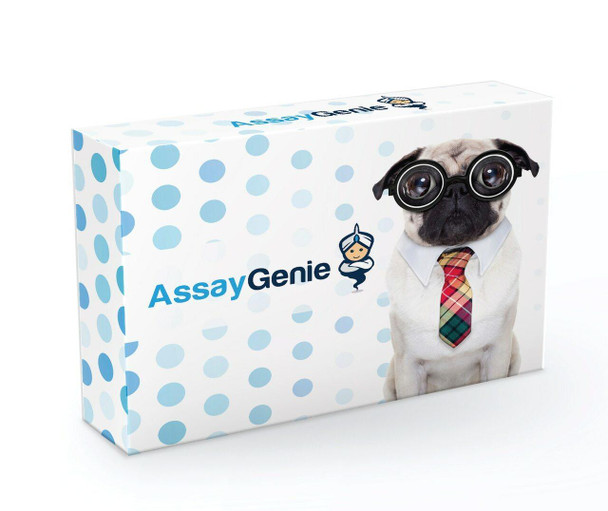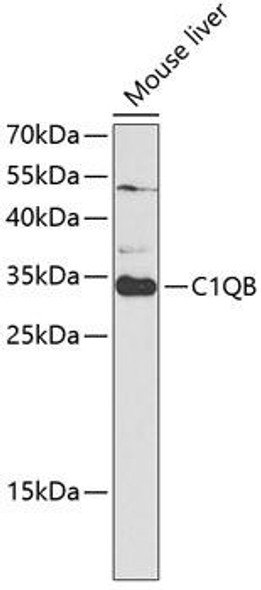Anti-PCGF2 Antibody (CAB17327)
- SKU:
- CAB17327
- Product type:
- Antibody
- Reactivity:
- Human
- Host Species:
- Rabbit
- Isotype:
- IgG
- Antibody Type:
- Polyclonal Antibody
- Research Area:
- Epigenetics and Nuclear Signaling
Frequently bought together:
Description
| Antibody Name: | Anti-PCGF2 Antibody |
| Antibody SKU: | CAB17327 |
| Antibody Size: | 20uL, 50uL, 100uL |
| Application: | WB |
| Reactivity: | Human |
| Host Species: | Rabbit |
| Immunogen: | Recombinant protein of human PCGF2. |
| Application: | WB |
| Recommended Dilution: | WB 1:500 - 1:2000 |
| Reactivity: | Human |
| Positive Samples: |
| Immunogen: | Recombinant protein of human PCGF2. |
| Purification Method: | Affinity purification |
| Storage Buffer: | Store at -20°C. Avoid freeze / thaw cycles. Buffer: PBS with 0.02% sodium azide, 50% glycerol, pH7.3. |
| Isotype: | IgG |
| Sequence: | Email for sequence |
| Gene ID: | 7703 |
| Uniprot: | P35227 |
| Cellular Location: | |
| Calculated MW: | 38kDa |
| Observed MW: | Refer to figures |
| Synonyms: | PCGF2, MEL-18, RNF110, ZNF144 |
| Background: | The protein encoded by this gene contains a RING finger motif and is similar to the polycomb group (PcG) gene products. PcG gene products form complexes via protein-protein interaction and maintain the transcription repression of genes involved in embryogenesis, cell cycles, and tumorigenesis. This protein was shown to act as a negative regulator of transcription and has tumor suppressor activity. The expression of this gene was detected in various tumor cells, but is limited in neural organs in normal tissues. Knockout studies in mice suggested that this protein may negatively regulate the expression of different cytokines, chemokines, and chemokine receptors, and thus plays an important role in lymphocyte differentiation and migration, as well as in immune responses. |
| UniProt Protein Function: | PCGF2: Transcriptional repressor. Binds specifically to the DNA sequence 5'-GACTNGACT-3'. Has tumor suppressor activity. May play a role in control of cell proliferation and/or neural cell development. Regulates proliferation of early T progenitor cells by maintaining expression of HES1. Also plays a role in antero- posterior specification of the axial skeleton and negative regulation of the self-renewal activity of hematopoietic stem cells. Component of a Polycomb group (PcG) multiprotein PRC1-like complex, a complex class required to maintain the transcriptionally repressive state of many genes, including Hox genes, throughout development. PcG PRC1 complex acts via chromatin remodeling and modification of histones; it mediates monoubiquitination of histone H2A 'Lys-119', rendering chromatin heritably changed in its expressibility. Is not functionally redundant with Bmi1; unlike Bmi1 does not stimulate the E3 ubiquitin-protein ligase activity in a reconstituted PRC1-like complex. |
| UniProt Protein Details: | Protein type:Ubiquitin conjugating system; Transcription factor; Ubiquitin ligase Chromosomal Location of Human Ortholog: 17q12 Cellular Component: nuclear chromatin; nucleoplasm; nucleus; PcG protein complex Molecular Function:protein binding; transcription factor activity Biological Process: negative regulation of transcription from RNA polymerase II promoter; protein sumoylation |
| NCBI Summary: | The protein encoded by this gene contains a RING finger motif and is similar to the polycomb group (PcG) gene products. PcG gene products form complexes via protein-protein interaction and maintain the transcription repression of genes involved in embryogenesis, cell cycles, and tumorigenesis. This protein was shown to act as a negative regulator of transcription and has tumor suppressor activity. The expression of this gene was detected in various tumor cells, but is limited in neural organs in normal tissues. Knockout studies in mice suggested that this protein may negatively regulate the expression of different cytokines, chemokines, and chemokine receptors, and thus plays an important role in lymphocyte differentiation and migration, as well as in immune responses. [provided by RefSeq, Jul 2008] |
| UniProt Code: | P35227 |
| NCBI GenInfo Identifier: | 462585 |
| NCBI Gene ID: | 7703 |
| NCBI Accession: | P35227.1 |
| UniProt Secondary Accession: | P35227,A6NGD8, |
| UniProt Related Accession: | P35227 |
| Molecular Weight: | 37,788 Da |
| NCBI Full Name: | Polycomb group RING finger protein 2 |
| NCBI Synonym Full Names: | polycomb group ring finger 2 |
| NCBI Official Symbol: | PCGF2 |
| NCBI Official Synonym Symbols: | MEL-18; RNF110; ZNF144 |
| NCBI Protein Information: | polycomb group RING finger protein 2 |
| UniProt Protein Name: | Polycomb group RING finger protein 2 |
| UniProt Synonym Protein Names: | DNA-binding protein Mel-18; RING finger protein 110; Zinc finger protein 144 |
| Protein Family: | Polycomb group RING finger protein |
| UniProt Gene Name: | PCGF2 |
| UniProt Entry Name: | PCGF2_HUMAN |






